SPECIFICATIONS
Torque Specifications
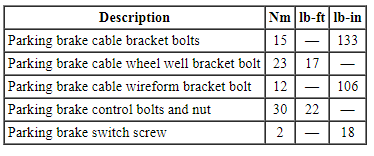
DESCRIPTION AND OPERATION
Parking Brake
The parking brake system consists of the following components:
- Parking brake control and front cable assembly
- Rear parking brake cables
The parking brake system is a mechanical system that activates a self-adjusting brake ratchet system within the rear brake caliper.
The parking brake system is cable-actuated and controlled by an independent foot-operated parking brake control. The parking brake system is actuated when the parking brake control is pressed and released by pressing the parking brake control a second time. The parking brake control applies tension to rear parking brake shoes through the front parking brake cable and conduit, and the LH and RH rear parking brake cables. The respective rear parking brake assemblies are then applied.
The parking brake cable tension is self-adjusting inside the parking brake control.
DIAGNOSIS AND TESTING
Parking Brake
Principles of Operation
Parking Brake System
The parking brake actuator is a spring-loaded, self-adjusting, foot-operated control. When the parking brake control is pressed once, tension is applied to the front parking brake cable. Pressing the pedal a second time releases the tension. This tension pulls on the RH rear parking brake cable. At the same time, the tension in the front cable causes the RH cable conduit to attempt to straighten out, causing tension that pulls the LH rear cable. Both cables are attached to their respective rear parking brake levers, applying the rear brake calipers. These levers actuate a mechanical corkscrew device inside the caliper piston. When the parking brake cable pulls on the lever, this corkscrew device pushes the piston against the pads. Normal brake pad wear allows the caliper piston to move outward from the caliper housing. This action maintains proper park brake adjustment.
Inspection and Verification
Check the operation of the parking brake system with the vehicle on a hoist and the parking brake control fully released. Check for any damaged cables and install new components as necessary.
The first indication that something may be wrong in the parking brake system is a change in the feeling through the parking brake control. The parking brake not holding on an incline or dragging after being released are also indicators of system concerns.
- Verify the customer concern.
- Visually inspect for obvious signs of mechanical damage.
Visual Inspection Chart

- If an obvious cause for an observed or reported concern is found, correct the cause (if possible) before proceeding to the next step.
- If the cause is not visually evident, verify the symptom and GO to Symptom Chart.
Symptom Chart
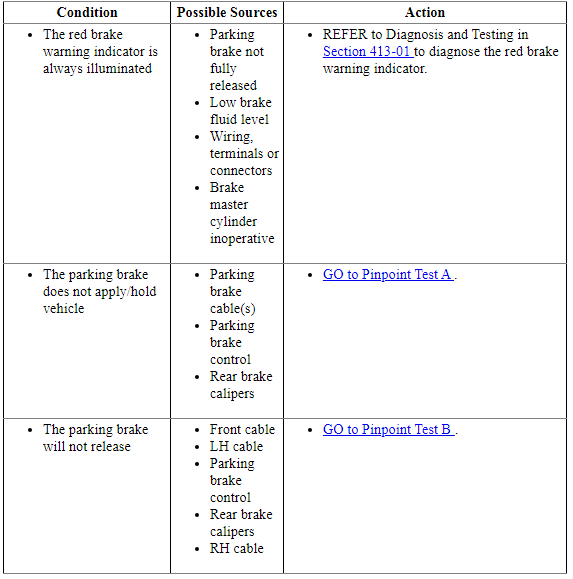
Pinpoint Tests
Pinpoint Test A: The Parking Brake Does Not Apply/Hold Vehicle
Normal Operation
When the parking brake control pedal is pressed, the pedal should move a short distance, with more pressure needed to apply the pedal as it gets closer to the floor, until the parking brake is fully applied. When the parking brake control is pressed, tension is applied to the front parking brake cable. This tension pulls on the RH rear parking brake cable, which is attached to the RH rear parking brake actuator, and applies the RH rear brake caliper. At the same time, the tension in the front cable causes the RH cable conduit to attempt to straighten out. This straightening effect causes tension that pulls the LH rear cable, which is attached to the LH rear parking brake actuator, and applies the LH rear brake caliper.
-
This pinpoint test is intended to diagnose the following:
- Front parking brake cable and conduit
- Parking brake control
- Rear parking brake cables and conduits
- Rear brake calipers
PINPOINT TEST A: THE PARKING BRAKE DOES NOT APPLY/HOLD VEHICLE
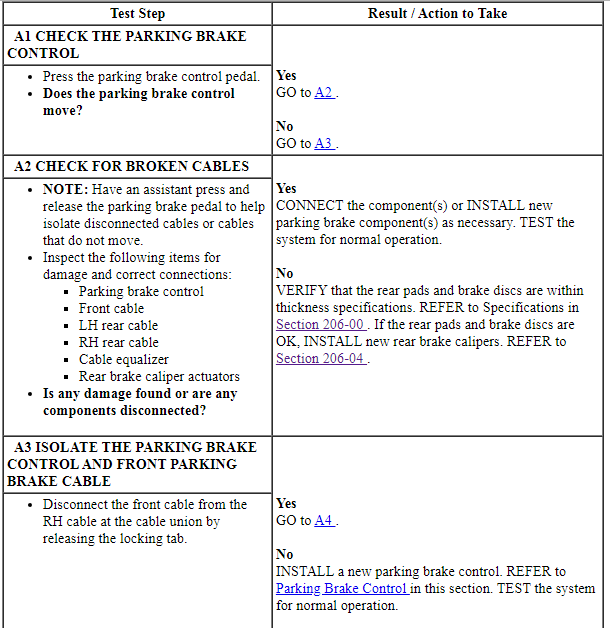
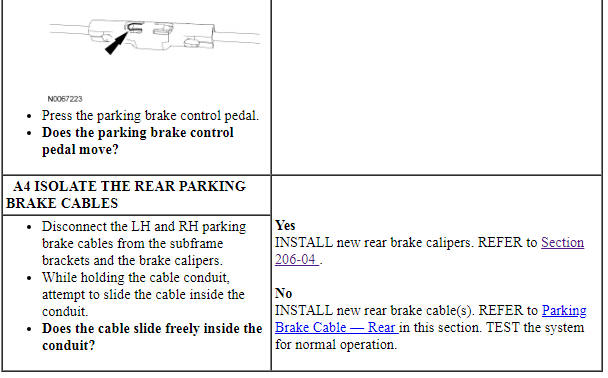
Pinpoint Test B: The Parking Brake Will Not Release
Normal Operation
When the parking brake control is fully applied and the pedal is pressed a second time, the ratchet mechanism in the parking brake control releases the tension on the parking brake cables and conduits. The springs on both rear brake calipers provide the force necessary to return the brake pads and cables to their released position.
-
This pinpoint test is intended to diagnose the following:
- Front parking brake cable and conduit
- Parking brake control
- Rear parking brake cable and conduit
- Rear brake calipers
PINPOINT TEST B: THE PARKING BRAKE WILL NOT RELEASE
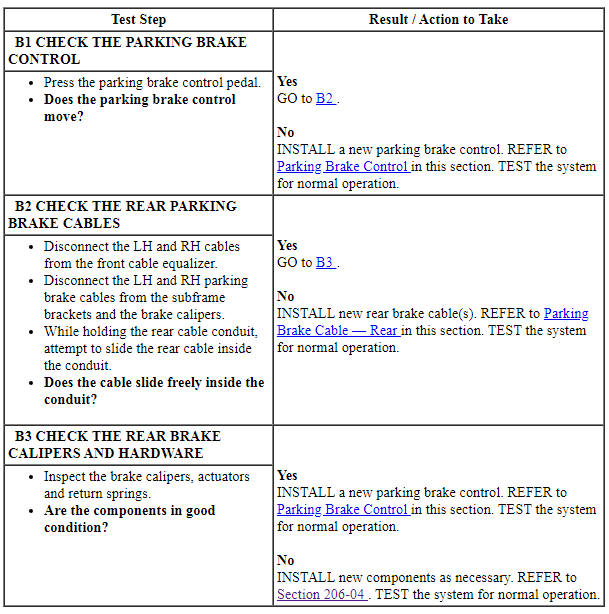
GENERAL PROCEDURES
Parking Brake Cable Tension Release
- With an assistant, release the parking brake cable tension by pulling down on the front cable at the cable-to-cable union until the parking brake control sector rotates to its stop and a 4 mm (0.15 in) x 150 mm (5.9 in) retainer pin can be inserted.
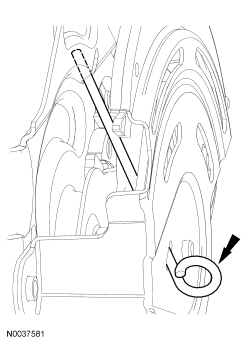
- With the vehicle in NEUTRAL, position it on a hoist. For additional information, refer to Section 100-02.
- NOTE: Make sure that the cable-to-cable union is connected to the
front and rear cable before removing the brake control retaining pin and
that the cable tension is reloaded slowly.
Disconnect the cable at the cable-to-cable union by releasing the locking tab.
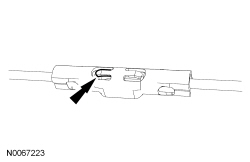
REMOVAL AND INSTALLATION
Parking Brake - Exploded View
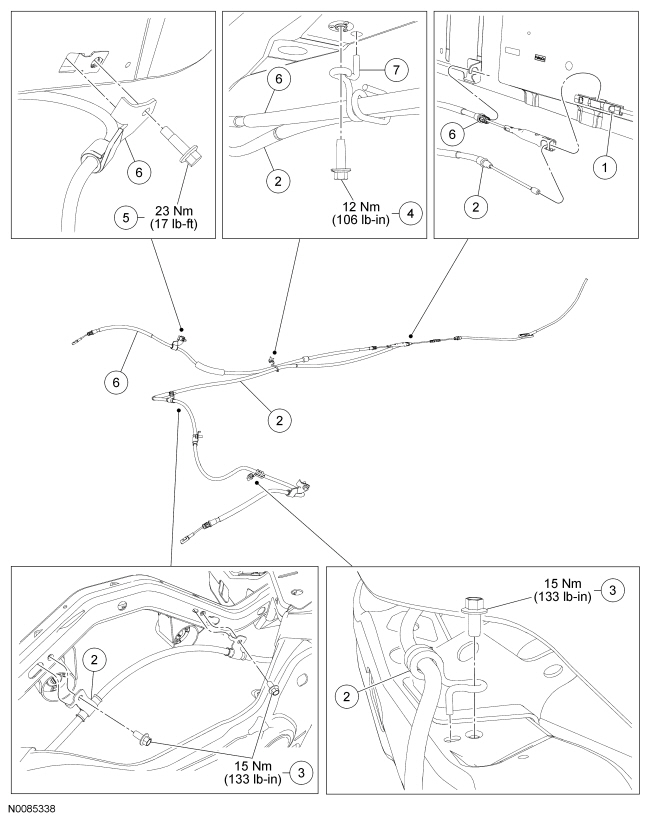
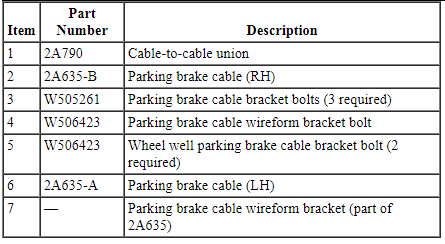
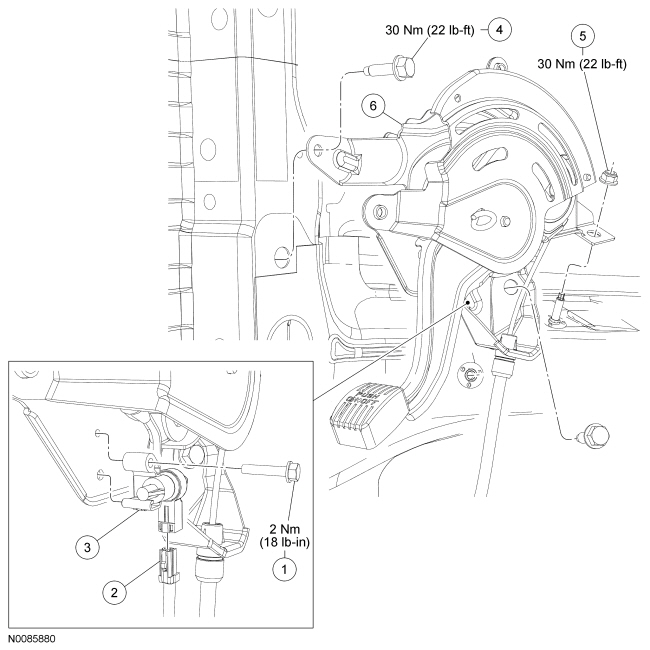
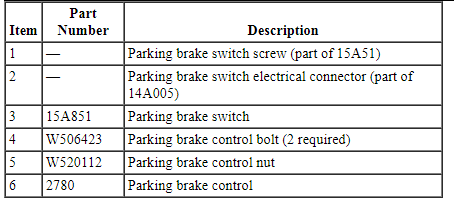
- For additional information, refer to the procedures in this section.
Parking Brake Cable - Rear
Removal and Installation
Both cables
- Release the parking brake cable tension. For additional information, refer to Parking Brake Cable Tension Release in this section.
RH cable
- Separate the RH cable from the LH at the conduit equalizer and remove the cable from the wireform bracket.
- Remove the 3 parking brake cable bracket bolts.
- To install, tighten to 15 Nm (133 lb-in).
- Remove the RH wheel well bracket bolt.
- To install, tighten to 23 Nm (17 lb-ft).
LH cable
- Disconnect the conduit equalizer from the RH cable at the equalizer.
- Remove the wireform bracket bolt and separate the LH cable and bracket
from the RH cable.
- To install, tighten bolt to 12 Nm (106 lb-in).
- Remove the LH wheel well bracket bolt.
- To install, tighten to 23 Nm (17 lb-ft).
Both cables
- Release the parking brake cable from the brake caliper and remove the cable.
- To install, reverse the removal procedure.
- Inspect the parking brake system for correct operation.
Parking Brake Control
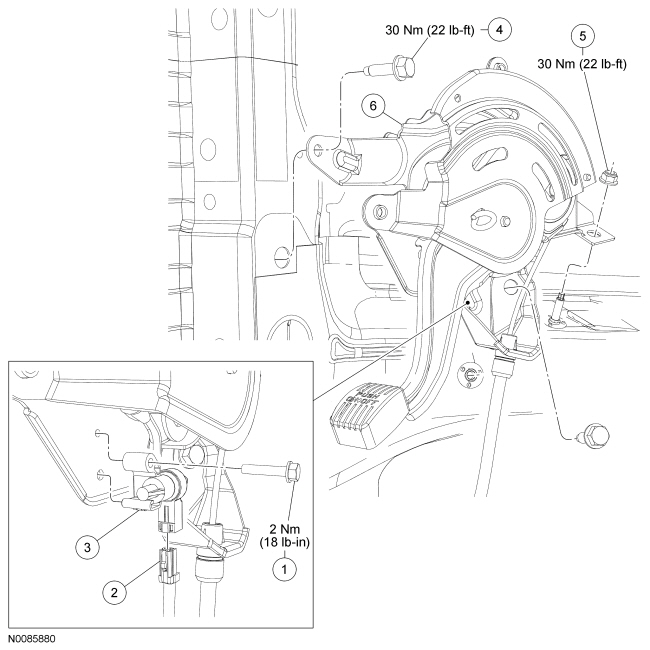
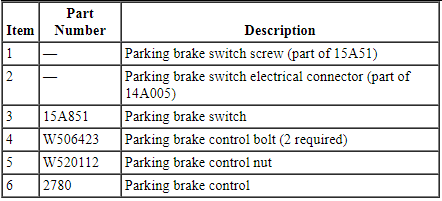
Removal and Installation
- With the vehicle in NEUTRAL, position it on a hoist. For additional information, refer to Section 100-02.
- Release the tension on the parking brake cable. For additional information, refer to Parking Brake Cable Tension Release in this section.
- Remove the Smart Junction Box (SJB) and bracket. For additional information, refer to Section 419-10.
- Remove the scuff plate trim panel and the lower cowl side trim panel. For additional information, refer to Section 501-05.
- Disconnect the parking brake switch electrical connector.
- Remove the parking brake control nut.
- To install, tighten to 30 Nm (22 lb-ft).
- Remove the 2 parking brake control bolts.
- To install, tighten to 30 Nm (22 lb-ft).
- Position the carpet aside and position the cable conduit grommet through the floor.
- Remove the parking brake control and front cable assembly.
- To install, reverse the removal procedure.
- Inspect the parking brake system for correct operation.
 Rear Disc Brake
Rear Disc Brake
SPECIFICATIONS
Torque Specifications
REMOVAL AND INSTALLATION
Brake Pads
Special Tool(s)
Material
Removal
WARNING:
Before beginning any service procedure in this section, refer to Safety Warnings ...
 Hydraulic Brake Actuation
Hydraulic Brake Actuation
SPECIFICATIONS
Material
Torque Specifications
DESCRIPTION AND OPERATION
Adjustable Pedals
Overview
The adjustable pedal feature uses an electrical motor to adjust the brake and
accelerator pedal po ...
Other materials:
Cleaning the windows and wiper blades
The windows and wiper blades should be cleaned regularly. If the wipers
do not wipe properly, substances on the vehicle’s glass or the wiper
blades may cause squeaking or chatter noise from the blades, and
streaking and smearing of the windshield. To clean these items, follow
these tips:
• ...
General Procedures
Window Grid Wire Repair
General Equipment
Material
NOTE: The grid line material is not embedded into the glass, but is
baked to the glass surface and consequently can be scraped off. An undamaged
grid line will have small ridges that project above the surface of the glass and
can easily be ...
Specifications, Description and Operation, General Procedures
SPECIFICATIONS
Material
General Specifications
Torque Specifications
a Tighten to 10 Nm (89 lb-in) plus an additional 720 degrees.
b Tighten to 16 Nm (142 lb-in) plus an additional 180 degrees.
c Refer to the procedure in this section.
d Tighten to 5 Nm (44 lb-in) plus ...
